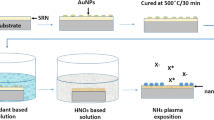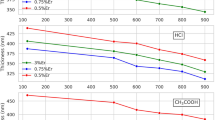Abstract
Deposition of silica thin films on silicon wafer was investigated by in situ mass measurements with a microbalance configured for dip coating. Mass change was recorded with respect to deposition time when the substrate was fully immersed in the silica sol. Mass gain during deposition was higher than predicted from monolayer coverage of silica nano particles. This implied that deposition was facilitated by gelling of the nanoparticles on the substrate. The rate of deposition was enhanced by increasing the particle concentration in the sol and by decreasing the particle size from 12 to 5 nm. Increasing the salt concentration of the silica sol at constant pH enhanced the deposition of the silica particles. Reducing the pH of the sol from 10 to 6 decreased the deposition rate due to aggregation of the primary silica particles.










Similar content being viewed by others
References
Kern W, Schuegraf KK (2002) In: Seshan K (ed) Handbook of thin-film deposition processes and techniques—principles, methods, equipment and applications, 2nd edn. William Andrew Publishing/Noyes, New York
Brinker JC, Scherer GW (1990) Sol-gel science: the physics and chemistry of sol-gel processing. Academic Press, London
Brinker JC, Frye GC, Hurd AC, Ashley CS (1991) Fundamentals of sol-gel dip coating. Thin Solid Films 201:97–108
Günther L, Peukert W (2003) Control of coating properties by tailored particle interactions: relation between suspension rheology and film structure. Colloid Surface A 225:49–61
Günther L, Peukert W, Goerigk G, Dingenouts N (2006) Microstructure formation in dip-coated particulate films. J Colloid Interf Sci 294:309–320
Horn RG (1995) In: Terpstra RA, Pex AC, De Vries AH (eds) Ceramic processing, 2nd edn. Springer, Berlin
Elimelech M, Gregory J, Jia X, Williams RA (1995) Particle deposition & aggregation measurement modelling and simulation, 1st edn. Butterworth—Heinemann, Woburn
Hiemenz PC, Rajagopalan R (1997) Principles of surface and colloid chemistry, 3rd edn. CRC Press, Boca Raton
Adamczyk Z (2003) Particle adsorption and deposition: role of electrostatic interactions. Adv Colloid Interfac 100–102:267–347
Buron CC, Filiâtre C, Membrey F, Perrot H, Foissy A (2006) Mass and charge balance in self-assembled multilayer films on gold. Measurements with optical reflectometry and quartz crystal microbalance. J Colloid Interf Sci 296:409–418
Enarsson LE, Wågberg L (2008) Conformation of preadsorbed polyelectrolyte layers on silica studied by secondary adsorption of colloidal silica. J Colloid Interf Sci 325:84–92
Kulkarni P, Sureshkumar R, Biswas P (2005) Hierarchical approach to model multilayer colloidal deposition in porous media. Environ Sci Technol 39:6361–6370
Kulkarni P, Sureshkumar R, Biswas P (2003) Multiscale simulation of irreversible deposition in presence of double layer interactions. J Colloid Interf Sci 260:36–48
Magan RV, Sureshkumar R (2006) Multiscale-linking simulation of irreversible colloidal deposition in the presence of DLVO interactions. J Colloid Interf Sci 297:389–406
Socha RP, Fransaer J (2005) Mechanism of formation of silica–silicate thin films on zinc. Thin Solid Films 488:45–55
Socha R, Pommier N, Fransaer J (2007) Effect of deposition conditions on the formation of silica-silicate thin films. Surf Coat Tech 201:5960–5966
Kern W, Puotinen DA (1970) Cleaning solutions based on hydrogen peroxide for use in silicon semiconductor technology. RCA Rev 31:187–206
Tsunoda K, Ohashi E, Adachi S (2003) Spectroscopic characterisation of naturally and chemically oxidized silicon surfaces. J Appl Phys 94:5613–5616
Angermann H (2008) Passivation of structured p-type silicon interfaces: effect of surface morphology and wet-chemical pre-treatment. Appl Surf Sci 254:8067–8074
Bertagna V, Erre R, Rouelle F, Chemla M, Petitdidier S, Levy D (2001) Electrochemical study for the characterisation of wet silicon oxide surfaces. Electrochim Acta 47:129–136
Kirby BJ, Hasselbrink EF Jr (2004) Zeta potential of microfluidic substrates: 1. Theory, experimental techniques, and effects on separations. Electrophoresis 25:187–202
Martin JE, Wilcoxon JP, Schaefer D, Odinek J (1990) Fast aggregation of colloidal silica. Phys Rev A 41:4379–4391
Hæeid S, Anderson J, Einarsrud MA, Hua DW, Smith DM (1995) Thermal and temporal aging of TMOS-based aerogel precursors in water. J Non Cryst Solids 185:221–226
Iler RK (1979) The chemistry of silica. Wiley, New York
Acknowledgments
This work was financially supported by The Research Council of Norway (NANOMAT, grant number 182033/S10). Bozena Tokarz, EKA Chemicals is acknowledged for a valuable discussion about silica sols.
Author information
Authors and Affiliations
Corresponding author
Rights and permissions
About this article
Cite this article
Guleryuz, H., Kaus, I., Filiàtre, C. et al. Deposition of silica thin films formed by sol–gel method. J Sol-Gel Sci Technol 54, 249–257 (2010). https://doi.org/10.1007/s10971-010-2190-0
Received:
Accepted:
Published:
Issue Date:
DOI: https://doi.org/10.1007/s10971-010-2190-0




